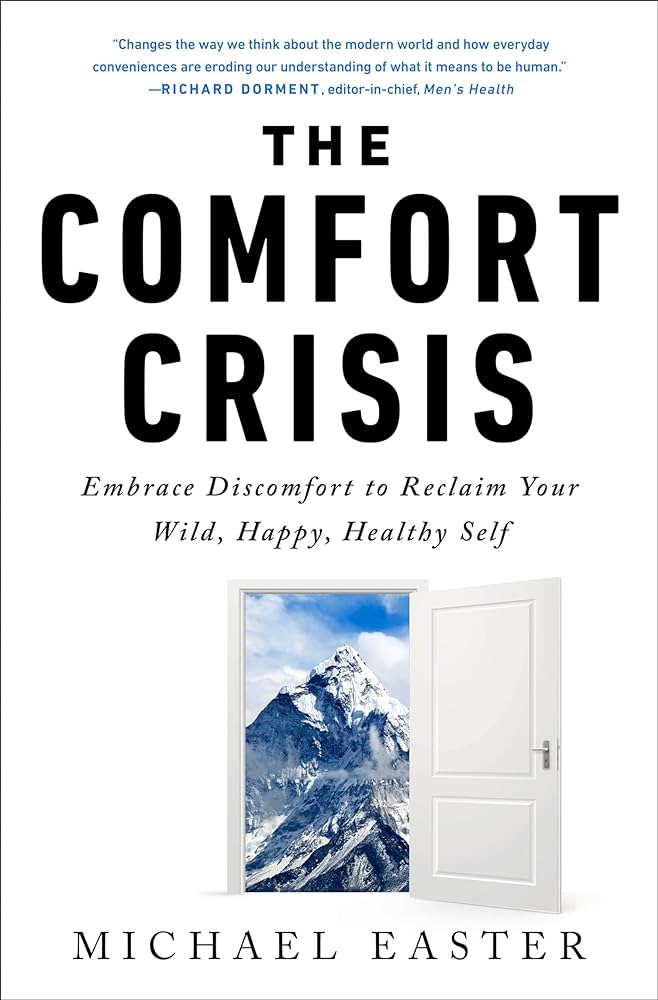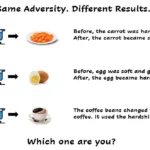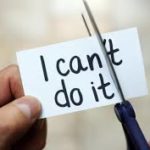In The Comfort Crisis: Embrace Discomfort To Reclaim Your Wild, Happy, Healthy Self, author Michael Easter provides a blueprint for leveraging the power of discomfort. Most people today rarely step outside their comfort zones. We are living progressively sheltered, sterile, temperature-controlled, overfed, underchallenged, safety-netted lives. And it’s limiting the degree to which we experience our “one wild and precious life,” as poet Mary Oliver put it.
But a radical new body of evidence shows that people are at their best—physically harder, mentally tougher, and spiritually sounder—after experiencing the same discomforts our early ancestors were exposed to every day. Scientists are finding that certain discomforts protect us from physical and psychological problems like obesity, heart disease, cancers, diabetes, depression, and anxiety, and even more fundamental issues like feeling a lack of meaning and purpose.
0.004 Percent
HUMANS EVOLVED TO seek comfort. We instinctually default to safety, shelter, warmth, extra food, and minimal effort. And that drive through nearly all of human history was beneficial because it pushed us to survive.
Discomfort is both physical and emotional. It’s hunger, cold, pain, exhaustion, stress, and any other trying sensations and emotions. Our comfort drive led us to find food. To build and take shelter. To flee from predators. To avoid overly risky decisions. To do anything and everything that would help us live on and spread our DNA. So it’s really no surprise that today we should still default to that which is most comfortable. Except that our original comforts were negligible and short-lived, at best. In an uncomfortable world, consistently seeking a sliver of comfort helped us stay alive. Our common problem today is that our environment has changed, but our wiring hasn’t. And this wiring is deeply ingrained.
Modern Comfort is New
Our species, called Homo sapiens, has been walking this earth for 200,000 to 300,000 years, depending on which anthropologist you ask. And we are highly evolved, despite what you may see on reality TV like Cops or any of the Housewives franchises. Early Homo sapiens developed complex tools, languages, cities, currency, farming, transportation systems, and much more. And that was before all of the human history we have written down, which is only about 5,000 years’ worth of time.
The modern comforts and conveniences that now most influence our daily experience—cars, computers, television, climate control, smartphones, ultraprocessed food, and more—have been used by our species for about 100 years or less. That’s around 0.03 percent of the time we’ve walked the earth. Include all the Homos—habilis, erectus, heidelbergensis, neanderthalensis, and us—and open the time scale to 2.5 million years and the figure drops to 0.004 percent. Constant comfort is a radically new thing for us humans.
“When our ancestors weren’t searching for food or getting pummeled by mastodons, they had long moments of downtime, lounging around for hours a day. They had to make something out of their boredom.”
The Death of Boredom
It wasn’t until the 1920s, when radio was broadcast to the masses, that there was a full-time, brainless escape from boredom. Then came Big TV in the 1950s. Finally, on June 29, 2007, boredom was pronounced dead, thanks to the iPhone. And so our imaginations and deep social connections went with it.
The Comfort Crisis
We lack physical struggles, like having to work hard for our livelihoods. We have too many ways to numb out, like comfort food, cigarettes, alcohol, pills, smartphones, and TV. We’re detached from the things that make us feel happy and alive, like connection, being in the natural world, effort, and perseverance.
Misogi: A circumnavigation of the edges of human potential.
An ancient Japanese practise involving purifying the mind, body, and spirit through physical and mental challenges.
“Misogis can show you that you had this latent potential you didn’t realize, and that you can go further than you ever believed. When you put yourself in a challenging environment where you have a good chance of failing, lots of fears fade and things start moving. Rule number one is that it has to be really fucking hard. Rule number two is that you can’t die.
“Modern humans may have an unmet need to do what’s truly difficult for us. New research shows that depression, anxiety, and feeling like you don’t belong can be linked to being untested.”
Nothing great in life comes with complete assurance of success. Engaging in an environment where there’s a high probability of failure, even if you execute perfectly, has huge ramifications for helping you lose a fear of failing. Huge ramifications for showing you what your potential is.
The Heroes Journey
Variations of the misogi myth exist through time and space. Greek, Mesopotamian, Buddhist, Norse, Christian, Hindu, and ancient Egyptian mythology all have some version of what Joseph Campbell called “the hero’s journey.
The hero exits the comfort of home for adventure. He’s hit with a challenge. It tests his physical, psychological, and spiritual fortitude. He struggles. Yet he manages to prevail. He returns with heightened knowledge, skills, confidence, and experience, and a clearer sense of his or her place in the world. And research going back to the late 1800s proves that mere mortals benefit from epic physical trials.
Arnold van Gennep – Rites of Passage
He found that these processes—whether walking around the outback, hunting a lion in Kenya, tripping out on the Columbia River Plateau, or perhaps, even, undergoing a misogi—all have three key elements.
Separation — Transition – Incorporation
- The first is separation. The person exits the society in which they live and ventures into the wild.
- The second is transition. The person enters a challenging middle ground, where they battle with nature and their mind telling them to quit.
- The third is incorporation. The person completes the challenge and reenters their normal life an improved person. It’s an exploration and expansion of the edge of a person’s comfort zone.
The case for fitness
Heart disease is the Jeffrey Dahmer of modern ailments. It kills more than 25 percent of us. That’s one person in the United States dying of it every 37 seconds. Expanding fitness just a bit—the equivalent of a person improving their max running speed from five to six miles an hour—reduces the risk of heart disease by 30 percent, according to the American Heart Association.
Next is cancer. It kills 22.8 percent of us. The most fit people face a 45 percent lower risk of dying from the disease, according to a study in the Annals of Oncology.
Then we have accidents. They take 6.8 percent of us. If a person is in a serious car accident, being in shape drops their chances of dying by 80 percent, according to a study in the Emergency Medical Journal. If the docs have to operate—regardless of whether it’s an emergency or a planned surgery—fitter people also face fewer surgical complications and recover faster than unfit people, say scientists in Brazil.
Lung disease gets 5.3 percent of us. Fitter people have lungs that are 2.8 times less at risk of disease, say scientists at Northwestern University.
“Keep descending the death list: stroke, diabetes, Alzheimer’s, and so on. Fitness fends off most maladies. Being out of shape is the new smoking, only worse. Research suggests that smoking takes 10 years off a person’s life, while the combined effects of being unfit may take as many as 23.
Research from the National Cancer Institute and Johns Hopkins suggests that the more a person marinates in exercise-induced discomfort, the more death resistant they’ll be.
A massive study discovered that for every small increase in fitness, a person’s risk of keeling over drops by 15 percent.
The Johns Hopkins scientists found that people who exercised more than three to five times the amount the government recommends were radically less likely to die. That’s between 450 and 750 minutes, or 7 and 12 hours a week.
All the best in your quest to get better. Don’t Settle: Live with Passion.



Comments are closed.